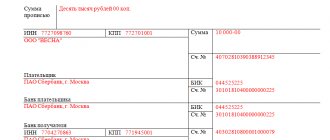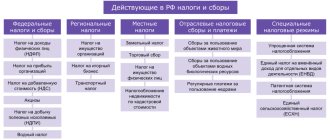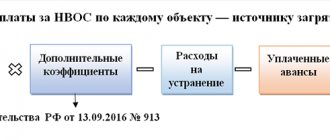OSNO companies pay tax on their profits in installments throughout the year. When the year ends, you need to calculate the annual tax amount and pay the difference. Advance payments for income tax are calculated and transferred in several ways. Let's figure out what this depends on and whether the organization has a choice. We will also look at possible calculation options using examples.
What are the types of advance payments for income tax?
Increasing the limit allowed a larger number of organizations to calculate advance payments for income tax based on the results of the quarter. Why this is good for taxpayers - let's look at an example, but first let's remember what advance payments for income tax are.
Based on the results of each reporting (tax) period, taxpayers calculate and pay advance payments in one of the following ways:
- based on the results of the 1st quarter, half a year and 9 months, as well as advance payments in each month of the next quarter, calculated taking into account the profit for the previous quarter (clause 2 of Article 286 of the Tax Code of the Russian Federation). Suitable for companies whose average revenue exceeded 15 million rubles over the previous four quarters;
- you can voluntarily switch to monthly advance payments based on actual profits (clauses 2 and 3 of Article 286 of the Tax Code of the Russian Federation). Suitable for companies whose average revenue exceeded 15 million rubles over the previous four quarters;
- based on the results of the 1st quarter, half a year and 9 months without paying monthly advance payments. This method is clause 3 of Art. 286 of the Tax Code of the Russian Federation is allowed to apply only to organizations whose revenue for the previous four quarters did not exceed an average of 15 million rubles for each quarter.
In 2021, the legislator set a revenue limit of an average of 25 million rubles for each quarter (Article 2 of Federal Law No. 121-FZ of April 22, 2020). In 2021, if the pandemic does not make any adjustments, the previous limit of 15 million rubles will be returned. The tax authority must be notified of the transition to monthly advance payments from actual profits by December 31 of the previous year. The notification can be submitted in free form or use the form recommended in the Letter of the Federal Tax Service dated April 22, 2020 No. SD-4-3/6802. In this case, the calculation of the amounts of advance payments is made by taxpayers based on the tax rate and the actual profit received, calculated on an accrual basis from the beginning of the tax period until the end of the corresponding month.
Let us calculate advance payments for the conditional Pineapples in Champagne LLC using each method, and then compare the results. Income and expenses for tax purposes are determined using the accrual method. The tax base for income tax is presented as a cumulative total from the beginning of the year on a quarterly and monthly basis.
| Period | 2020 | 2021 |
| Tax base for income tax | Tax base for income tax | |
| 1st quarter | 160 thousand rubles. (1 month: 50 thousand rubles; 2 month: 100 thousand rubles; 3 month: 160 thousand rubles) | 90 thousand rubles. (1 month: 30 thousand rubles; 2 month: 60 thousand rubles; 3 month: 90 thousand rubles) |
| 2nd quarter | 350 thousand rubles. (4th month: 230 thousand rubles; 5 month: 300 thousand rubles; 6 month: 350 thousand rubles) | 50 thousand rubles. (4th month: 70 thousand rubles; 5 month: 60 thousand rubles; 6 month: 50 thousand rubles) |
| 3rd quarter | 620 thousand rubles. (7 months: 400 thousand rubles; 8 months: 500 thousand rubles; 9 months: 620 thousand rubles) | 150 thousand rubles. (7 months: 80 thousand rubles; 8 months: 120 thousand rubles; 9 months: 150 thousand rubles) |
| 4th quarter | 900 thousand rubles. (10 months: 700 thousand rubles; 11 months: 800 thousand rubles; 12 months: 900 thousand rubles) | 370 thousand rubles. (10 months: 230 thousand rubles; 11 months: 300 thousand rubles; 12 months: 370 thousand rubles) |
Results
The rules for determining the amount of monthly advances paid on profit are established by the Tax Code of the Russian Federation and are described in relation to each quarter. This value is determined for each subsequent quarter by the amount of actually calculated tax attributable to the previous quarter. The monthly advance is taken from this amount as 1/3. Receiving a loss at the end of a quarter eliminates the need for advance payments in the following quarter.
See also the article “Advance payments for income tax: who pays and how to calculate”.
Sources:
- Tax Code of the Russian Federation
- Federal Law of April 22, 2020 No. 121-FZ
You can find more complete information on the topic in ConsultantPlus. Free trial access to the system for 2 days.
How to calculate advance payments based on quarterly results
The amount of the quarterly advance payment at the end of the reporting period is determined by the actual profit, calculated on an accrual basis from the beginning of the tax period to the end of the reporting period - quarter, half-year, nine months. In this case, advance payments previously paid in the tax period are taken into account.
Example 1: let’s calculate quarterly advance payments for 2021 for Pineapples in Champagne LLC:
- based on the results of the 1st quarter: 90 thousand rubles × 20% = 18 thousand rubles.
- Based on the results of the 2nd quarter, a loss of 40 thousand rubles was received. This means that the tax base for the six months will be 50 thousand rubles. That is, the advance payment for the six months will be 50 thousand rubles × 20% - 18 thousand rubles = - 8 thousand rubles. According to the formula, we understand that we have overpaid taxes, so we will not pay anything to the budget for the six months.
- based on the results of 9 months: 150 thousand rubles × 20% = 30 thousand rubles. If the overpayment of 8 thousand rubles, resulting from the results of the six months, is not offset against the payment of other taxes and is not returned to the organization, it is offset against the payment of the quarterly advance payment based on the results of 9 months (clause 1 of Article 287, clause 14 of Article 78 of the Tax Code RF). Therefore, the amount to be paid additionally to the budget: 30 thousand rubles – 18 thousand rubles = 12 thousand rubles.
How are taxes calculated?
To correctly calculate how much tax you need to pay, you need to know which expenses and income should be included in the report, and which do not need to be indicated. The law allows two methods for determining the dates when these transactions can be recognized.
First method. Accrual
The time of actual receipt of funds or incurrence of costs does not play any role. Income and expenses are recognized when they are reflected in the documents. If the income of funds and expenses have an indirect relationship that cannot be clearly determined, the company itself distributes income using the principle of uniformity. The date of sale of finished goods (provision of services) is considered the date of the transaction. It doesn’t matter when exactly the money arrived.
The date of receipt of non-operating revenue is recognized as follows:
- for dividends - the date when the money arrived in the recipient’s current account;
- for donated property or other similar income - the date of signing the acceptance and transfer document.
Second method. Cash
The cash method is the exact opposite of the accrual method. The date of receipt of profitability is the date of receipt of money at the cash desk or in the current account of the enterprise, receipt of property rights, etc. Costs are recognized only after they are paid, that is, when the money leaves the cash register.
On a note! Only companies whose average quarterly profitability for the previous year reached a maximum of 1 million rubles have the right to use the cash method.
How to calculate monthly down payments
Unlike the advance payment based on the results of the quarter, the monthly advance payment is determined not from the actual, but from the estimated profit, which is determined based on the results of the previous quarter. An exception is the monthly payments of the first quarter of the current tax period: they are equal to the payments that were paid in the fourth quarter of the previous tax period. The calculation is described in detail in paragraph 2 of Art. 286 Tax Code of the Russian Federation.
Important: if during the current quarter an organization receives less profit or even a loss, this does not exempt it from paying monthly advance payments. They are recognized as an overpayment, which can be returned to the current account, offset against future payments, or used to pay off other taxes (in the federal and regional parts).
Example 2: let’s calculate the advance payments that Pineapples in Champagne LLC will transfer in 2021, taking into account monthly advance payments:
- payments in January, February and March 2021 are equal to the monthly advance payment that was paid in the fourth quarter of the previous year:
(620 thousand rubles × 20% − 350 thousand rubles × 20%) / 3 = 18 thousand rubles per month.
- The advance payment based on the actual results of the first quarter amounted to 18 thousand rubles. There was an overpayment of tax: (18 thousand rubles × 3 − 18 thousand rubles) = 36 thousand rubles.
The monthly advance payment in the 2nd quarter of the current year is equal to: 18 thousand rubles / 3 = 6 thousand rubles. The organization counted the overpayment against these payments, but even taking this into account, at the end of the 2nd quarter there remained an overpayment:
(36 thousand rubles − 6 thousand rubles × 3) = 18 thousand rubles.
- in July, August and September, the organization did not transfer payments, since the difference between the quarterly and advance payments for the half year and 1st quarter of 2021 was negative.
The quarterly advance payment for 9 months amounted to 30 thousand rubles. The organization closed part of it by overpayment, and paid the rest to the budget:
(30 thousand rubles − 18 thousand rubles) = 12 thousand rubles.
- For this option, you can already calculate payments due in October, November and December 2021 and the 1st quarter of the next year:
(30 thousand rubles − 0 rubles) / 3 = 10,000 rubles.
Deadlines
The company must make a payment every month during the calendar year. But the period January-December is not considered reporting; there is no requirement to pay an advance for this time at the beginning of the next year.
The calendar year January-December is recognized as a tax period, so tax money must be sent no later than March 28 of the year following the reporting year.
Example. In 2021, Avtotransport LLC paid every month from February to December. The total amount was 100,000 rubles. At the end of the year, the company must pay 120,000 rubles, i.e. 20,000 rubles remained unpaid at the beginning of the new year 2021. They must be submitted by March 28, 2018.
Payments are made monthly
How to calculate monthly down payments based on actual profits
In this case, tax is paid on the actual profit received for the previous month. The tax payment date is the 28th day of the month following the reporting period. We calculate the advance payment using the formula:
AP = NB × C – APpr, where
- AP - advance payment for the reporting period;
- NB - tax base;
- C—income tax rate;
- APPR - advance payments for previous periods.
Example 3: let’s calculate the advance payments that Pineapples in Champagne LLC will transfer in 2021, taking into account monthly advance payments based on actual profits:
- In January, a profit of 30 thousand rubles was received, therefore, in February the company will pay 30 thousand rubles × 20% = 6 thousand rubles;
- In January-February, the tax base is 60 thousand rubles, the tax payable in March will be 60 thousand rubles × 20% - 6 thousand rubles = 6 thousand rubles;
- In January - March, the base is 50 thousand rubles, the tax payable is 90 thousand rubles × 20% - 6 thousand rubles - 6 thousand rubles = 6 thousand rubles;
- in January - April the tax base will be 70 thousand rubles, therefore, in May you need to pay 70 thousand rubles × 20% - 6 thousand rubles - 6 thousand rubles - 6 thousand rubles = - 4,000 rubles. Since the number comes out with a minus, it means the company has overpaid. There is no need to pay taxes for April. Likewise, there will be no tax due in May, June, July and August;
- Each subsequent month is calculated using the formula above. For convenience, we have collected all payments in a table.
P period The tax base Tax payable for the period Advance payment taking into account previous payments Advance payment date January 30000 6000 6000 March 1, 2021 January February 60000 12000 6000 March 29, 2021 January March 90000 18000 6000 April 28, 2021 January - April 70000 14000 0 May 28, 2021 January - May 60000 12000 0 June 28, 2021 January June 50000 10000 0 July 28, 2021 January - July 80000 16000 0 August 30, 2021 January - August 120000 24000 6000 September 28, 2021 January - September 150000 30000 6000 October 28, 2021 January - October 230000 46000 16000 November 29, 2021 January - November 300000 60000 14000 December 28, 2021
What is considered income?
Profit is the difference between cash (or property) inflows and business expenses. Income includes not only income from sales, but also any other earnings of the company. For example, interest on deposits in financial institutions or profit from renting out real estate. When taxing, value added tax and excise taxes are deducted from income.
Amounts received by the organization are confirmed by:
- tax accounting documents;
- primary documents;
- other documents confirming receipt of money.
Companies do not pay taxes on all proceeds. The law defines several types of income that are exempt from taxation:
- contributions to the company's management company;
- property acquired in the form of collateral or deposit;
- property issued on credit;
- an object of possession received free of charge.
The organization must take into account all other proceeds when calculating tax.
Payment schedule and withdrawals
Taking into account the deadlines specified in paragraph 1 of Art. 287 of the Tax Code of the Russian Federation, we will draw up a payment schedule for Pineapples in Champagne LLC:
| Advance payments only at the end of the quarter | Advance payments based on quarterly results with monthly payments | Advance payments on actually received profits with monthly payments | |
| until 01/28/2021 | 2 thousand rubles additional payment for 2021 + 18 thousand rubles | 20 thousand rubles (for January 2021) | |
| until 03/01/2021 | 18 thousand rubles | 6 thousand rubles | |
| until March 29, 2021 | 56 thousand rubles (based on the results of the fourth quarter of 2021: 900 thousand rubles × 20% - 124 thousand rubles) | 18 thousand rubles | 6 thousand rubles |
| until 04/28/2021 | 18 thousand rubles | overpayment credited | 6 thousand rubles |
| until 05/28/2021 | overpayment credited | — | |
| until 06/28/2021 | overpayment credited | — | |
| until July 28, 2021 | — | — | — |
| until 30.08.2021 | — | — | |
| until 09.28.2021 | — | 6 thousand rubles | |
| until 28.10.2021 | 12 thousand rubles | 12 thousand rubles + 10 thousand rubles | 6 thousand rubles |
| until 29.11.2021 | 10 thousand rubles | 16 thousand rubles | |
| until 12/28/2021 | 10 thousand rubles | 14 thousand rubles |
It is more profitable for the taxpayer to pay advance payments based on the results of the past quarter or month: in fact, they are paid according to real profits, and not “in advance.” Monthly advance payments based on payments from the previous quarter are really payment in advance from the money that could be put into circulation. This is especially felt when there was a good result for 9 months, and then a decrease in profit or even a loss: the organization still must transfer advance payments, moreover, calculated for “profitable” periods.
Returning to the news under discussion: whether the organization will make monthly advance payments or may limit itself to quarterly payments depends on the average revenue for the past 4 quarters. Let's remember how to calculate it.
What expenses to record?
Expenses are expenses of a business. They need to be justified and confirmed with documents. Expenses are divided into two groups:
- Expenses for the sale or production of goods and services - personnel wages, depreciation deductions, purchase of primary raw materials and other material expenses.
- Non-operating expenses - legal costs, losses due to negative exchange rates, etc.
On a note! Taxation does not take into account expenses for loan repayment, transfers to the organization's management company, dividend payments, etc.
Selling costs can be direct or indirect. The first category includes the enterprise’s costs for labor, material costs, and depreciation. Each month, direct costs are distributed by the enterprise and included in the cost of the final product or work in progress. This type of expense reduces the tax base strictly as the goods (services) are sold, in the price of which they are taken into account. What exactly is included in the list of direct expenses is decided by the taxpayer himself, in accordance with his accounting policies.
Indirect costs are costs that are neither direct nor non-operating. They cannot be part of the cost of the final product (service provision). Indirect costs include rent, utilities and other expenses associated with the operation of the company. When calculating income tax, this type of expense must be included in the expenses of the current reporting period.
The procedure for calculating average income
The calculation takes into account income from the sale of goods, works, services and property rights specified in Art. 249 of the Tax Code of the Russian Federation. Non-operating income and income listed in Art. 251 of the Tax Code of the Russian Federation are not taken into account. Sales proceeds are taken without VAT and excise taxes.
The average sales revenue for the previous four quarters is the sum of sales revenue for each of the previous four consecutive quarters divided by four. If it exceeds the limit, the organization will make monthly advance payments from the next quarter. This limit was raised back in 2021 from 10 to 15 million rubles.
Example 4: Let's see if Pineapples in Champagne LLC is required to pay monthly advance payments during 2021.
- For the first quarter, income received in the 1st – 4th quarters of 2020 is taken: (10.5 million rubles + 8 million rubles + 13 million rubles + 13.5 million rubles) = 45 million rubles
45 million rubles / 4 = 11.25 million rubles This is less than 15 million rubles, which means that in the first quarter the organization is not obliged to make monthly advance payments.
Payment options
Only some companies are given the opportunity to pay taxes not monthly, but less often - every quarter. The following are entitled to relief:
- representative offices of foreign companies constantly conducting commercial activities on the territory of the Russian Federation;
- budgetary organizations (exceptions - museum, theater, library);
- companies with small profits - no more than 15 million for each of the four previous quarters;
- autonomous institutions;
- organizations conducting non-profit activities.
Other companies must remit tax every month. The law provides two payment options:
- Deposit funds monthly and pay the balance quarterly.
- Calculate the amount of monthly advances based on the profit received by the organization in the previous month.
Newly created organizations
Companies that have just started operating always pay tax for the first quarter based on the results of the quarter, regardless of revenue. And after the first quarter, they choose one of the tax payment methods.
Newly created organizations pay advance payments quarterly for the corresponding reporting period, provided that sales revenue does not exceed 15 million rubles per quarter. If revenue exceeds these limits after a full quarter, then advances will have to be made monthly based on the profit of the previous quarter.
Calculate your income tax using the online service Kontur.Accounting. Here you can easily do accounting, calculate salaries, pay taxes, automatically generate reports and send them online.
Who should pay
Obligations to pay income tax are assigned to the following organizations:
- OJSC, CJSC, LLC, i.e. all Russian legal entities.
- Foreign organizations that have actual management in the country.
- Foreign companies recognized as tax residents of the Russian Federation.
- Legal entities that are foreigners but receive income from Russian sources.
- Permanent representative offices of foreign companies in the country.
The following are exempt from paying tax:
- organizations that do not have taxable objects;
- enterprises applying a specialized tax regime;
- companies participating in the innovative.
Reflection of advance payments in the declaration
When filling out the declaration, indicate only the accrued amounts of payments and do not indicate the actual amounts transferred. Thus, if according to the tax base an organization must transfer 10 thousand rubles monthly, but paid only 8 thousand, then in the declaration it must indicate the amount of 30 thousand. The difference is compensated when calculating the advance at the end of the fourth quarter. However, the taxpayer can reimburse it himself within a year.
What to do in case of overpayment?
If there was a mistake and you overpaid more tax than necessary, you can get your money back. The taxpayer has 3 years from the date of filing the tax return rather than paying the advance. If tax officials do not agree to return the money, insist. The law is on your side.
How do enterprises that are deprived of the right to use the simplified taxation system pay income tax?
If a company's income exceeds the limit established by the state, the commercial enterprise is deprived of the right to a simplified tax payment regime. The first time after losing the simplified tax system, the company must make tax payments as a new organization, that is, transfer advance payments every 30 days, starting from the end of the entire quarter. The date of formation of the company will be considered the date when it made the transition to the standard tax system.
If an organization switched to the regular system from the beginning of October 2016, then it must begin making contributions after the end of the fourth quarter of 2021. Advances must go to the budget starting in January 2021. But, according to the law, the amount of advances for the first quarter is equal to the amount of advances for the fourth quarter. Since there are no contributions for that period, the company has no way to calculate the payment amount. Therefore, the obligation to transfer payments arises for our organization only in the second quarter of 2017.
Penalties for non-payment of tax
If an organization does not transfer tax money within the prescribed period, it faces penalties. The tax office has the right to collect the required amount from the debtor at the expense of the property or withdraw it from the bank account.
Within three months after the delay is discovered, the company is sent a demand for payment of income tax. This document indicates the repayment period and amount of the debt.
On a note! The decision to collect the tax debt is made a maximum of 2 months after the payment deadline has expired.
If you transfer an advance payment for a smaller amount than indicated in the declaration, the tax office has the right to forcibly collect the difference. Transferring an insufficient amount may result in a penalty. But, if the initially declared amount exceeds the actual profit, the amount of the penalty may be recalculated.
Penalty for late submission of a declaration to the tax authorities
For some reason you forgot to submit your return on time? In our article you can familiarize yourself with the list of tax sanctions, and also consider options for reducing the amount of the fine.
Features of calculations
When calculating advance payments, the taxpayer has the right to apply an investment deduction. This opportunity can be used for fixed assets put into operation from 2021 to 2027 and belonging to depreciation groups 3-7. Thanks to this feature, companies can reduce taxes by 90%, transferred to the regional budget, and the remaining 10% to the federal budget. However, decisions to reduce the tax base are made at the regional level, but there is no particular specificity in this regard.
Organizations have the right to deduct from the total tax deduction:
- money that was received free of charge from enterprises in which they are the owner of shares or a participant. Only the amount of money that was invested in the property is taken into account;
- profit of shareholders upon exit from a liquidated enterprise, whose shareholder is this organization. The excess from investments made, that is, dividends received, are taken into account. They are subject to a 13% rate in accordance with existing legislation;
- the program is valid in full for payments using the Platon system;
- employers have the right to reduce profits by paying travel packages to their employees.
Tax legislation is reviewed every year and amendments, additions and changes are made to it.
…at the end of each reporting period plus monthly during this period
The essence of this method is that the organization, focusing on the actual indicators of the previous quarter, makes monthly advance payments (MAP) to the budget, then at the end of the reporting period pays an advance payment (AP), based on the actual profit received for the reporting period and taking into account previously made payments.
At the same time, according to paragraph. 2 – 5 p. 2 tbsp. 286 of the Tax Code of the Russian Federation, the amount of the EAP is equal to:
- in the 1st quarter – the amount of the UAP payable in the 4th quarter of the previous tax period;
- in the 2nd quarter – 1/3 of the amount of the AP based on the results of the 1st quarter;
- in the third quarter – 1/3 x (AP based on the results of the first half of the year – AP based on the results of the first quarter);
- in the fourth quarter - 1/3 x (AP based on the results of nine months - AP based on the results of the half-year).
If the amount of the monthly advance payment calculated in this way is negative or equal to zero, these payments are not made in the corresponding quarter ( paragraph 6, paragraph 2, article 286 of the Tax Code of the Russian Federation ).








